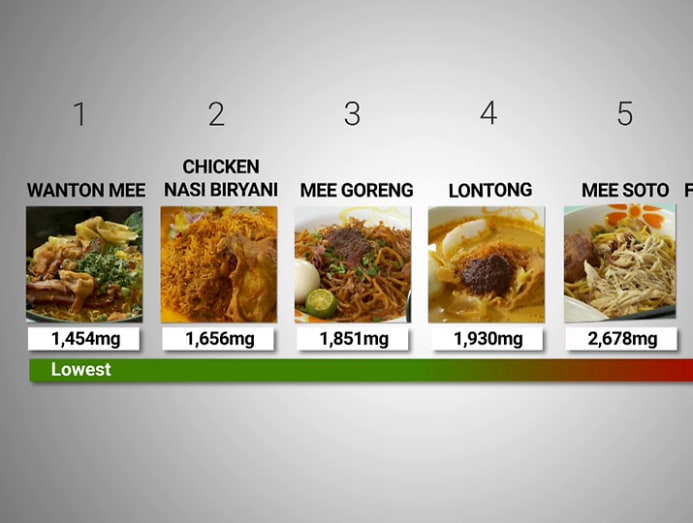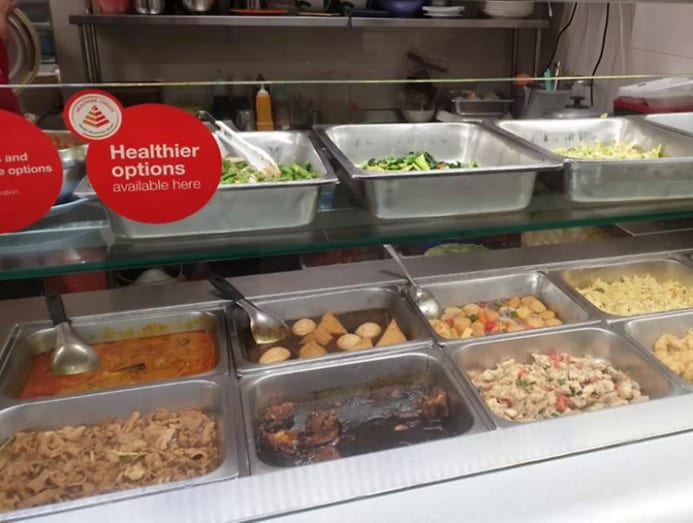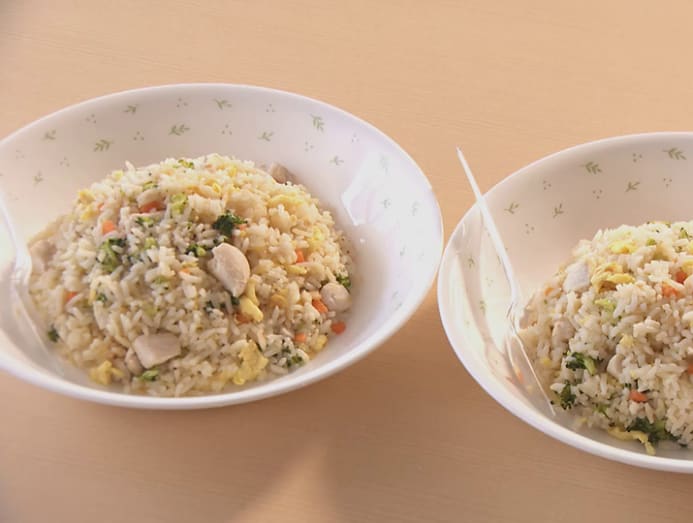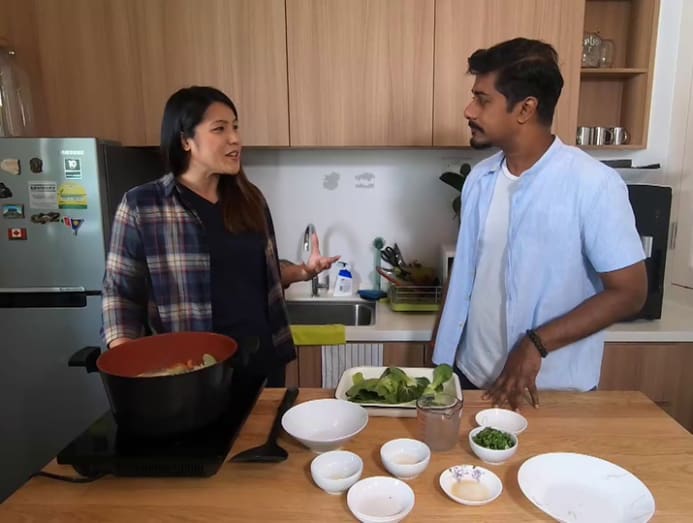Want to cut back on salt and still have tasty meals? Here are 7 tips
Too much salt can be a health risk, but that has not deterred Singaporeans. The programme Talking Point finds out what’s behind the nation’s high daily intake, and some surprising facts about the popular flavouring.

Six dishes, but which has the most salt? You may be surprised at the answer.
SINGAPORE: Chicken biryani and fried fish soup with milk are among Singaporeans' favourite hawker dishes. But guess which one has more salt.
It turns out that fish soup will bust your daily salt limit.
Already, the average Singaporean consumes 9g of salt daily, according to the National Nutrition Survey 2018. This is almost double the 5g intake (slightly less than a teaspoon) recommended by the World Health Organisation and the Health Promotion Board (HPB).
Singapore’s salt consumption also ranks up there with countries like China, England and the United States.
Salt adds flavour to food, but too much of it in one’s diet can lead to health problems such as hypertension — and an increased risk of stroke and kidney failure.
Is it possible, however, to have delicious low-salt meals?

Talking Point host Rai Kannu, who has a family history of hypertension, tried to stick to less than a teaspoon of salt a day for two weeks, to see if Singaporeans would be able to reduce their daily salt intake.
Here are seven things he learnt about salt along the way:
1. IT IS NOT NECESSARILY A VILLAIN
Salt, which is made up of sodium and chlorine, is the main dietary source of sodium, so the terms “salt” and “sodium” are often used interchangeably.
In 5g of salt, the recommended daily intake, there would be 2,000mg of sodium. And it is an essential part of one’s diet. Sodium helps to transmit nerve impulses, keeps muscles working properly and maintains the body’s fluids in balance.
WATCH: How to go on a low-salt diet in Singapore? Rai tries for 2 weeks (6:30)
But too much sodium can lead to water retention in the body, which then increases blood volume and leads to high blood pressure (hypertension). This will, in turn, increase the risk of stroke, heart disease and kidney failure.
2. IT IS HIDING IN THE SAUCES
Most of Singaporeans’ dietary sodium comes from sauces, seasoning and condiments, according to William Chen, the director of Nanyang Technological University’s Food Science and Technology Programme.
A tablespoon of oyster sauce has about 500mg of sodium, while the same amount of soya sauce has about 1,000mg of sodium. And there is about 1,500mg of sodium per tablespoon of fish sauce.
“When we cook a dish, usually we don’t really measure how much we add in, so all these together contribute to the high level of sodium in the dishes,” said the professor.

This is why “fish soup may seem to be less oily” than dishes like mee goreng and lontong, “but it actually contains a lot of sodium”.
3. EATING OUT DRIVES UP THE SALT INTAKE
Since about 2011, the HPB has tried to educate Singaporeans about reducing their salt intake. But the “growing trend of eating out” has led to higher overall salt consumption, said HPB senior manager (policy and strategy development) Melissa Koh.
The HPB has the Healthier Dining Programme to partner the food and beverage industry to provide lower-calorie meals with the Healthier Choice Symbol. But the statutory board might now go a step further.
“We’re now studying the need and the feasibility of extending this to lower-sodium labels,” said Koh, who has been studying how to get food operators to reduce the sodium level in their dishes.

4. LOW-SODIUM SUBSTITUTES ARE AVAILABLE
The HPB has also conducted trials with two “major” caterers. “Both, during the study period, switched over to reduced sodium salt, sauces and seasonings,” cited Koh, a nutritionist. “Sodium reduction was significant — about 30 to 38 per cent across sites.”
She said most of the consumers in the trials could not tell the difference.
“(Among) those who actually could taste the difference, some liked the lower-sodium taste, which means there’s still that margin where food service operators can reduce their sodium without compromising taste,” she added.
When Rai did a similar taste test, he did not notice any difference either.

Low-sodium salt has part of the sodium chloride removed and replaced with potassium chloride or other mineral salts, leaving it with typically 40 per cent less sodium than regular salt, Koh explained.
It is safe for “a majority of the population”, though she noted: “Those with impaired kidney function will need to be a bit more careful because it does increase the risk of hyperkalaemia (too much potassium in the blood).”
5. AVOID PROCESSED FOODS AT HOME
Cooking at home helps to control one’s dietary sodium, and consumers can ensure this by sticking to non-processed foods and avoiding deep-fried stuff, recommends sports and nutrition coach Aqilah Norazman, the founder of Asian Meal Prep.
“Even when you’re choosing veggies, try as much as possible to go raw and minimise the ones that are cooked with a lot of stock … and a lot of gravy,” she said.

She also recommends herbs, spices and natural flavour enhancers, like onions or spring onions, instead of salt.
“Even the healthiest food has a little bit of sodium in it, so you don’t need to add in any extra salt,” she said.
6. IS ONE TEASPOON REALLY THE LIMIT?
There are “definitely benefits” of keeping to the recommended level, said Singapore Heart Foundation senior nutritionist Lim Kiat. Reducing the global salt intake to less than 5g per day could prevent 2.5 million deaths annually, he cited.
In Singapore, nearly one in four residents aged 30 to 69 — and more than half of those aged 60 to 69 — have hypertension, he noted.

“Hypertension is a silent killer, which means it doesn’t cause any symptoms even when the condition is severe,” he added.
“Hypertension is one of the key risk factors for cardiovascular disease. It impacts around one out of three deaths in Singapore.”
7. TWO WEEKS CAN MAKE A DIFFERENCE
Dr Tan and Partners’ chief medical officer, Julian Ng, who tracked Rai’s health markers before and after the latter’s two-week regimen, said a low-salt diet helps mainly to prevent blood pressure problems from developing rather than improving the blood pressure.
For example, Rai’s blood pressure, which was normal all along, was unchanged. But his level of aldosterone, a hormone that helps to regulate blood pressure, nearly doubled because of his reduced salt intake.
WATCH: A 2-week low-sodium diet: Can I live on 1 teaspoon of salt per day? (22:12)
With the increase, his body keeps his blood pressure and heart rate under control. “You obviously don’t want wild fluctuations,” said Ng.
A long-term high-salt diet, however, would “signal to the body” to set a “new normal”.
“And over time, due to increasing age and all the various factors, the body would try to reset the blood pressure point,” he added. “It actually starts to increase.”
Watch this episode of Talking Point here. The programme airs on Channel 5 every Thursday at 9.30pm.






